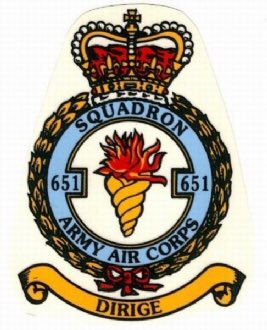
The Army Air Corps (AAC) is a component of the British Army, first formed in 1942 during the Second World War by grouping the various airborne units of the British Army. Today, there are eight regiments of the AAC as well as four Independent Flights and two Independent Squadrons deployed in support of British Army operations around the world. Regiments and flights are located in the United Kingdom, Brunei, Canada, and Germany. Some AAC squadrons provide the air assault elements of 16 Air Assault Brigade through Joint Helicopter Command.

The Shek Kong Airfield, formerly Royal Air Force Station Sek Kong or Sek Kong Airfield, is an airfield (airbase) located in Shek Kong, New Territories, Hong Kong.

The Westland Scout is a light helicopter developed by Westland Helicopters. Developed from the Saro P.531, it served as a land-based general purpose military helicopter, sharing a common ancestor and numerous components with the naval-orientated Westland Wasp helicopter. The type's primary operator was the Army Air Corps of the British Army, which operated it in several conflict zones including Northern Ireland and the Falklands War.

667 Squadron AAC is a squadron of the British Army's Army Air Corps (AAC).

Number 7 Flight Army Air Corps was an independent flight of the British Army's Army Air Corps, latterly based at the British garrison at Medicina Lines in Seria, Brunei, on the island of Borneo.

Army Aviation Centre (AAC) Middle Wallop is a British Army airfield located near the Hampshire village of Middle Wallop, used for Army Air Corps training. The base hosts 2 (Training) Regiment AAC and 7 (Training) Regiment AAC under the umbrella of the Army Aviation Centre. 2 (Training) Regiment performs ground training; 7 (Training) Regiment trains aircrew on AAC aircraft after they complete basic training at RAF Shawbury.

656 Squadron AAC is a squadron of the British Army's Army Air Corps. It was chosen as one of the AAC new Apache squadrons and in April 2004 started its conversion to role. The first phase of this completed in October 2004. The squadron was the first operational Apache squadron in the Army Air Corps and was awarded fully operational status along with the remainder of 9 Regiment AAC in June 2005. It is under 4 Regiment AAC as of 2007.

No. 651 Squadron Army Air Corps, is an aircraft squadron of the British Army, originally formed as No. 651 Squadron Royal Air Force in Italy and North Africa during the Second World War, and afterwards in Egypt. Numbers 651 to 663 Squadrons of the RAF were Air Observation Post units which had both Army and RAF personnel. The pilots, drivers and signallers were in the Royal Artillery whilst the adjutants, technical staff and equipment officers came from the RAF. Air observation posts were used primarily for artillery spotting, but occasionally for liaison and other duties. Their duties and squadron numbers were transferred to the Army with the formation of the Army Air Corps on 1 September 1957.
653 Squadron AAC is a squadron of the British Army's Army Air Corps (AAC). It traces much of its history to No. 653 Squadron Royal Air Force, an Air Observation Post Squadron active from 20 June 1942 – 15 September 1945, during and after the Second World War. These units spotted targets for the British Army and flew liaison tasks.
2 (Training) Regiment Army Air Corps is a regiment of the British Army's Army Air Corps. It is responsible for all of the Army Air Corps' groundcrew Phase 2 and 3 training, as well as the Ground Support Commanders Course for officers. The Regiment is based at Middle Wallop and is made up of two squadrons:

No. 662 Squadron AAC is a squadron of the British Army's Army Air Corps (AAC) which flies the AgustaWestland Apache AH.1 from Wattisham Airfield as part of 3 Regiment Army Air Corps.

658 Squadron AAC is an Army Air Corps unit of the British Army that provides dedicated aviation support to the 22nd Special Air Service Regiment for domestic counter terrorism (CT) operations. The squadron is co-located with 22 SAS at Stirling Lines. The press has given the squadron, their helicopters, and the CT response force they enable, the nickname "Blue Thunder". The squadron is part of the Joint Special Forces Aviation Wing.
No. 660 Squadron AAC is a squadron of the British Army's Army Air Corps (AAC). The squadron traces its lineage to a Royal Air Force squadron that existed during the Second World War. In the late 1950s the squadron's numerical was transferred to the AAC and since its formation in 1969, it has operated as a British Army unit flying various types of battlefield helicopters. The squadron has been re-formed and disbanded on a number of occasions. The squadron is currently based at RAF Shawbury where it forms part of No. 1 Flying Training School, but it has been deployed operationally to Northern Ireland, Hong Kong and Brunei throughout its existence.
No. 654 Squadron AAC was a squadron of the British Army's Army Air Corps (AAC).
1 Regiment Army Air Corps is a regiment of the Army Air Corps (AAC).
5 Regiment Army Air Corps is a regiment of the British Army and is part of the Joint Helicopter Command (JHC). The regiment is based in Northern Ireland at JHC Flying Station Aldergrove.
No. 652 Squadron AAC is a squadron of the British Army's Army Air Corps (AAC).
No. 661 Squadron AAC is a squadron of the British Army's Army Air Corps (AAC).
No. 659 Squadron AAC is a squadron of the British Army's Army Air Corps (AAC) based at RNAS Yeovilton flying AgustaWestland Wildcat AH.1's as part of 1 Regiment Army Air Corps.
7 (Training) Regiment Army Air Corps is a regiment of the British Army and is part of the Joint Helicopter Command. The regiment is responsible for providing all of the flight training of Army Air Corps (AAC) pilots. The regiment is based at the Army Aviation Centre at Middle Wallop.










